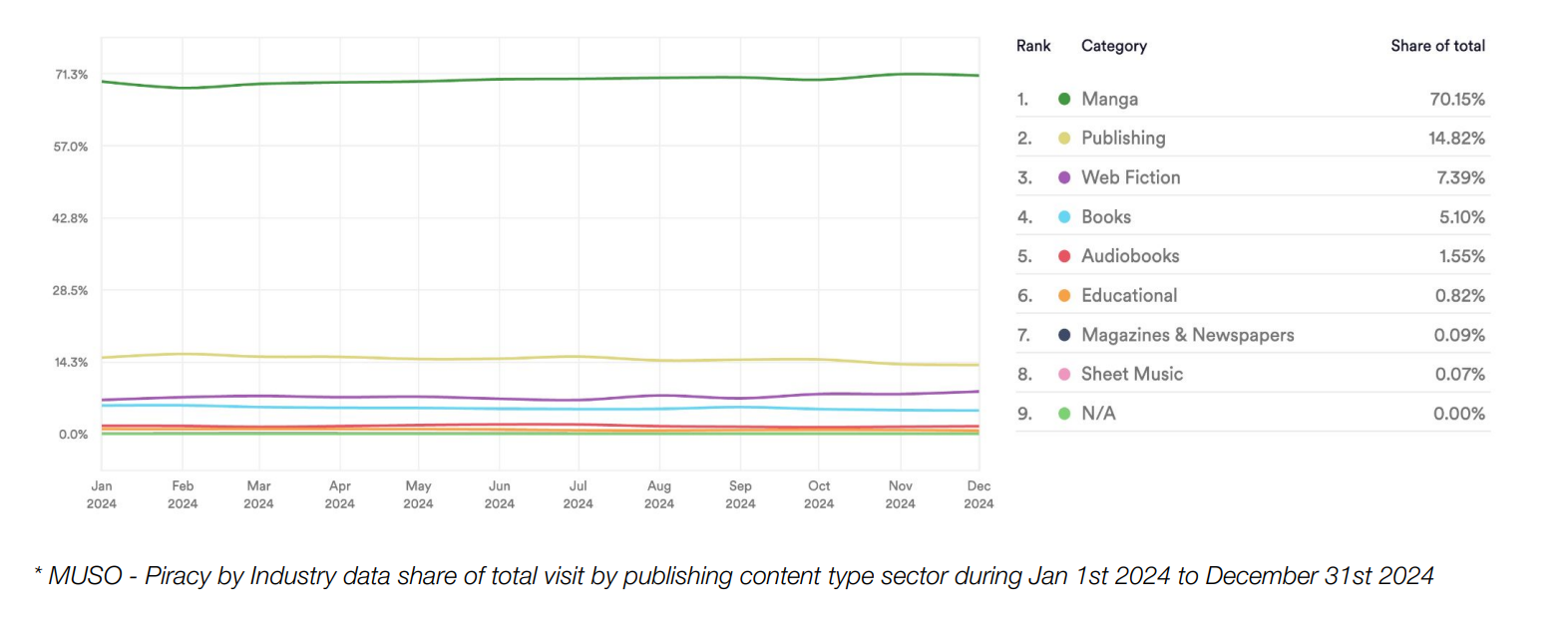Data analytics company MUSO released its 2024 report on piracy trends, estimating that while piracy as a whole is down by 5.72% from 2023, an increase in publishing piracy, with manga holding strong and steady, was a notable highlight.
ALSO READ:
MangaDex Says It’s Not Shutting Down in Official Response After ‘Approximately 7,000 Titles’ Hit by DMCA Takedowns
MUSO estimates that manga piracy accounted for 70.15% of tracked publishing piracy, equating to 46.57 billion visits to manga piracy websites in 2024. Publishing piracy was MUSO’s only content category to register an increase compared to 2023 (4.3%). MUSO tracks TV, publishing, film, software, and music piracy. Manga piracy as a share of publishing piracy was stable over the last year despite mounting anti-piracy efforts, and slightly increased its share and actual visit count compared to 2023. You can check out the composition of publishing piracy below.

Here’s a comparison of publishing piracy from 2023 (via MUSO):

The United States was the world leader in publishing piracy, followed by Indonesia. U.S. Congresswoman Zoe Lofgren recently tabled a bill aimed at blocking foreign piracy websites. This is being supported by Congressman Darrell Issa, who is working on his own anti-piracy bill, as reported by Torrent Freak.
The U.S. was also the world leader in piracy generally, with a share of 12.33%. India (8.12%) and Russia (7.12%) completed the top three. Anime companies are taking notable steps to curb piracy in India. This includes Crunchyroll, which offers low-cost subscriptions and dubbing in multiple local languages, in addition to increasing awareness campaigns as Sony launches FAST (Free Ad-supported Streaming Television) channels in the region. Anime productions adapting Indian stories and mythology are also in the works. Meanwhile, legacy anime franchises like Crayon Shin-chan and Naruto have seen their first-ever film releases in India this year.
Hideo Katsumata, the president of AnimeTimes, an anime licensor, streaming service, and merch producer, recently shared the company’s efforts over the last two years to expand in India (via Gamebiz).
North America has also seen a rapid rise in FAST channels offering anime content. These act as a funnel to legitimate streaming services, introducing free titles to viewers while increasing legitimate brand recognition. HIDIVE has recently rolled out on several smart TV providers, as well as new anime channels on Pluto TV and Sling TV Freestream in May.
ALSO READ:
‘Crunchyroll Is Doing Its Best, But…’: Suzume Studio Founder Hopes Toho Provides Healthy Anime Competition in America
Anime piracy stood out within the breakdown of TV piracy. While pirated anime consumption paled behind films & TV shows (60.25%), anime piracy was second with 27.76%. This was almost triple live sports in third with 10.28%. Earlier this year, MUSO and Variety reported that anime made up eight of the top 10 most pirated TV shows as measured by Demand (a score that weights watch time, as well as social media, search engine queries, and several other metrics). The U.S. was again the world leader of TV piracy — nearly double Russia.

You can read the full report via MUSO. Headquartered in London, the company is considered a leading figure in piracy data tracking, with its data cited by rightsholders and organizations like WIPO and EUIPO.
Featured image ©Gege Akutami/Shueisha





















